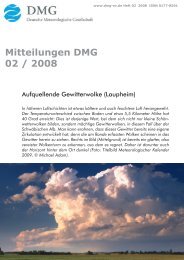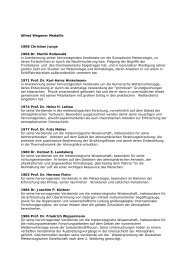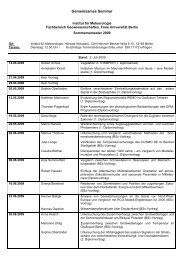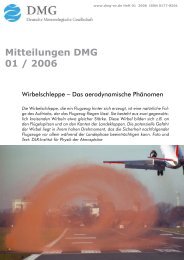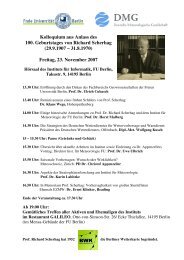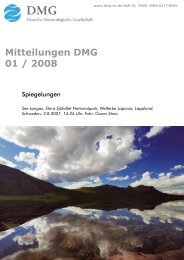Proceedings zur 6. Fachtagung BIOMET - Deutsche ...
Proceedings zur 6. Fachtagung BIOMET - Deutsche ...
Proceedings zur 6. Fachtagung BIOMET - Deutsche ...
Sie wollen auch ein ePaper? Erhöhen Sie die Reichweite Ihrer Titel.
YUMPU macht aus Druck-PDFs automatisch weboptimierte ePaper, die Google liebt.
Coupling soil water and tree transpiration in the vegetation-boundary-layer model<br />
HIRVAC<br />
Valeri Goldberg, Björn Fischer und Christian Bernhofer<br />
Technische Universität Dresden, Department of Meteorology<br />
Abstract<br />
This study presents an approach to describe the coupling mechanism between soil moisture,<br />
tree transpiration and atmospheric boundary layer by upgrading the coupled vegetation<br />
boundary layer model HIRVAC. For that, several parameters of the included gas exchange<br />
model PSN6 were scaled by the matrix potential to consider the stomatal reaction to changes<br />
in soil water content. This leads to an adaptation in the additional humidity source term in the<br />
basic equation of HIRVAC. As a result the humidity profiles in the canopy air, the latent heat<br />
flux and the energy balance of each canopy model layer are changed.<br />
The new parameterisation in HIRVAC was applied for the VERTIKO special observation<br />
period in May and June 2003 for vegetation parameters adapted to the Anchor Station Tharandter<br />
Wald (experimental site of the Department of Meteorology, TU Dresden). The simulations<br />
showed a realistic decrease of evapotranspiration for dry soil conditions. Without coupling<br />
latent heat flux increased continuously due to an increase of the atmospheric driving<br />
parameters vapour pressure deficit and temperature. Despite some differences during the<br />
night the correlation between measured and simulated LE was adequately moderate.<br />
Kopplung von Bodenwasser und Baumtranspiration im Vegetations-<br />
Grenzschichtmodell HIRVAC<br />
Zusammenfassung<br />
In der vorliegenden Studie wird ein Ansatz <strong>zur</strong> Beschreibung der Kopplungsmechanismen<br />
zwischen Bodenfeuchte, Baumtranspiration und atmosphärischer Grenzschicht mit Hilfe des<br />
aktualisierten gekoppelten Vegetations-Grenzschicht-Modell HIRVAC vorgestellt. Dazu werden<br />
verschiedene Parameter des in HIRVAC integrierten Gaswechselmodells PSN6 über das<br />
Matrixpotential skaliert, um die Stomatareaktion auf einen geänderten Bodenwassergehalt zu<br />
berücksichtigen. Dies führt zu einer Anpassung des zusätzlichen Quellterms in der Feuchtegleichung<br />
von HIRVAC. Als Ergebnis werden das Feuchteprofil in der Bestandesluft, der<br />
latente Wärmestrom (LE) und die Energiebilanz jeder Bestandesmodellschicht verändert. Die<br />
neue Parametrisierung wurde in einer speziellen Messperiode im BMBF - Verbundprojekt<br />
VERTIKO im Mai / Juni 2003 für die Vegetationszusammensetzung am Experimentalstandort<br />
im Tharandter Wald angepasst. Die Modellsimulationen zeigten einen realistischen Rückgang<br />
der Verdunstung für trockene Bedingungen. Ohne Kopplung von Vegetation und Grenzschicht<br />
stieg LE kontinuierlich an, verursacht durch einen Anstieg der atmosphärischen Steuergrößen<br />
Temperatur und Sättigungsdefizit. Im Vergleich mit der gemessenen Verdunstung<br />
zeigten sich moderate Abweichungen, besonders in der Nacht.<br />
1 Introduction<br />
Latent and sensible heat are important variables in meteorology, hydrology and ecology, as<br />
they interact with local climate by mass and energy exchange between the ground and the<br />
atmosphere. To reduce uncertainty in predictions of surface energy exchange or to fill data<br />
gaps a better understanding of ecosystem processes controlling energy and water balance<br />
components is required (FALGE et al., 2005).<br />
111






